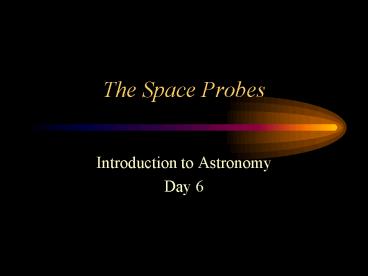The Space Probes - PowerPoint PPT Presentation
1 / 19
Title:
The Space Probes
Description:
Examine the flight paths of Voyager 1 and Voyager 2 on the following . ... Flight Paths of Voyager 1 and Voyager 2. Day 295: Entering the Asteroid Belt ... – PowerPoint PPT presentation
Number of Views:47
Avg rating:3.0/5.0
Title: The Space Probes
1
The Space Probes
- Introduction to Astronomy
- Day 6
2
The Voyager Discoveries
- Early voyagers sailed the seas and discovered new
lands. They returned to report their findings.
The Voyager spacecraft also discovered new lands,
but they reported by sending back images and
information that have kept scientists busy for
years.
3
Voyager Space Journey Picture Study
- Imagine going on a journey that takes you from
Cape Canaveral in Florida, past Mars, and finally
near the giants planets of Jupiter, Saturn,
Uranus, and Neptune. You would see sights that
human eyes have never seen before. - We will use the following picture study to take
this journey. - Pay attention and contemplate the questions that
I ask. Write your responses in you Science
Journal.
4
Day 1 Blastoff
- How would you feel to be leaving on such a
journey?
5
Day 215 Crossing the orbit of Mars
- Examine the flight paths of Voyager 1 and Voyager
2 on the following slide. - Did the Voyager spacecraft travel in the same
direction? - Which planets did each spacecraft fly by?
- How long did it take Voyager 2 to reach Uranus?
- According to the diagram, what happened to the
spacecraft?
6
Flight Paths of Voyager 1 and Voyager 2
7
Day 295 Entering the Asteroid Belt
- What is the asteroid belt? Will this be dangerous?
8
Day 475 Leaving the Asteroid Belt
- Will you be glad to leave the Asteroid Belt?
9
Day 570 Looking at Jupiter from a distance.
- What do you see? Describe Jupiter to someone who
has not seen it before. How many features can you
describe?
10
Day 630 Observing the Great Red Spot
- What words could describe your view? What is the
great red spot? How large is it?
11
Day 650 Examining some satellites of Jupiter
- Jupiter has 16 satellites, three of which are
larger than Earths moon. What is a satellite?
How are the four satellites shown here different?
Which one appears to be volcanically active?
Which one could be covered with a thick layer of
fractured ice?
12
Day 662 On the way to Saturn
- What will you do for the next 905 days?
13
Day 1567 Encountering Saturn
- How is Saturn similar to Jupiter? How is it
different?
14
A Journey through the Milky Way and Beyond
- Now that we have taken a pictorial journey
through a part of our solar system, lets take a
look at what it would be like to travel through
space to the furthest known expanse of our
universe! - Milky Way and Beyond!
15
The Hubble Deep Field The Most Important Image
Ever Taken
- In 2003, the Hubble Space Telescope took the
image of a millenium, an image that shows our
place in the universe. Anyone who understands
what this image represents, is forever changed by
it. - A Hubble Journey.
16
Magellan-Mapping a Distant World
- Ferdinand Magellan, a Portuguese explorer in
service to Spain, mapped the coastlines of the
Americas in the early 1500s. The spacecraft
Magellan, launched into space in 1989, orbited
and mapped a more distant land a planet called
Venus. The information that Magellan sent back to
Earth enables us to know more about the surface
of Venus than we know about that of Earth. Thats
because much of Earths surface is covered with
water and ice, which hide its surface features. - The surface of Venus is hidden from observers on
Earth by a thick layer of clouds. Some early
astronomers suggested that rivers, streams, and
perhaps even living things may lie beneath the
clouds. Could this be true?
17
Could living things survive on Venus?
- Surface Temperature is about 500 degrees
Centigrade - Very dense atmosphere of carbon dioxide
- Atmospheric pressure is about 90 times that on
Earth - Clouds are made up of sulfuric acid
18
Magellan continued
- How did Magellan penetrate the cloud cover to see
the surface below? - It used microwave radiation, which can penetrate
clouds. The reflected signals were sent back to
Earth, where computers formed them into images.
Its work finished, Magellan plunged into the
thick, hot Venusian atmosphere in October of
1994. The spacecraft was crushed by the pressure
of Venus atmosphere.
19
Some Magellan Images































